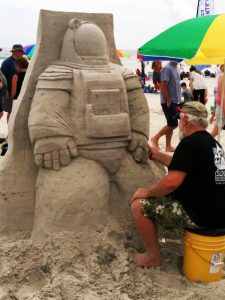(Creative tinkering is the 4th of a 9-part series on creativity traits.)
Curious: passionate for fresh knowledge; desiring to learn new things
Resilient: capable of overcoming setbacks; able to take risks; ambitious
Evaluative: willing to experiment and evolve your creativity beyond the idea stage
Autonomous: independent; norm-doubting
Tuned in: open and alert to the world around you; highly perceptive
Introspective: driven by innate (intrinsic) rewards; self-accepting
Visionary: having dreams and aspirations; original thinking
Energetic: adept at managing and recharging your energy

Sand sculpture tinkerers at New Smyrna Beach, FL
Some people believe that creativity is all about a single Eureka moment when a fully-formed idea simply jumps out. Sometimes that might happen. But not usually.
It’s more likely that creative types are tinkerers – testing, modeling and experimenting with their ideas, often in a trial-and-error mode. They continually evaluate what does and does not work. They evolve their ideas beyond their embryonic beginnings.
What is a tinkerer?
I came across Rachelle Doorley’s definition of tinkerer on TinkerLab. While the site is intended for childhood education, several concepts are appropriate here as well. (In fact, you might want to take a look at TinkerLab for inspiration!) So, here is her definition of a tinkerer:
“one who experiments with materials and ideas to fully understand their capacities, and who further iterates on their learning to find better solutions to current problems.”
Note that her definition mentions the importance of continually iterating on learning. In other words, a tinkerer is a dabbler. An experimenter. A hands-on adapter. A maker. Tinkerers “play around” with ideas. They don’t necessarily accept their first idea as is.
The tinkering process helps redefine problems and solutions. And the more idea variations you have, the higher the probably of having a good one in the pile. Nobel Laureate Linus Pauling said: “I am constantly asked by students how I get good ideas. My answer is simple: First, have a lot of ideas. Then, throw away the bad ones.”
Ideas evolve through creative tinkering
Think about all of the different types of people who tinker. And think about the variety of disciplines they represent.
- Fiction writers try out various plots and characters before finalizing a story line.
- Product designers experiment with various materials, components and approaches to prototyping.
- Artists test new combinations of colors, shapes and textures.
- Photographers shoot from different angles, with different lenses, under different lighting conditions to see what happens.
Evaluation is integral to improving and/or prioritizing ideas. Look at your brainchild from multiple perspectives. What are the relevant facts? Are there better or different alternatives? What are the benefits and advantages of each? What are your gut reactions – how do you feel about it? Why is the idea good, and what can be done to make it successful? What are the risks and negatives, and why might it NOT be successful?
I started writing fiction a couple of years ago, thinking that because I wrote successful business books I could easily make the shift to mysteries. Wrong. I had to learn about characterization. Plotting. Scene development. And the planting of clues and red herrings. I am finally making progress but it took a lot of tinkering. And evaluating. And really listening to members of my critique groups. Believe me, I learned I could not leave my ideas in their original conditions. (Some were dead on arrival!)
Yes, tinkering is necessary for creativity to blossom. And it’s not necessarily a solo activity.
Makers help evolve creative ideas
The Maker Movement is a social movement of people who want to create. Anything. Some makers are do-it-yourselfers. Others are professional inventors. But at heart they are tinkerers. And they share learning in many ways. One is through Maker Faires, defined on the namesake website as follows:
Part science fair, part county fair, and part something entirely new, Maker Faire is an all-ages gathering of tech enthusiasts, crafters, educators, tinkerers, hobbyists, engineers, science clubs, authors, artists, students, and commercial exhibitors. All of these “makers” come to Maker Faire to show what they have made and to share what they have learned.
The Maker Movement has been enabled by technology (such as crowdsourcing and 3-D printing), and plays a role in some corporate product development. GE, for example, has used the concept of makers as a new paradigm in manufacturing. A few years ago, they invited makers from across the globe to submit ideas as part of an innovation challenge. They received many novel concepts for their aviation products. Some may have eventually emerged from internal R&D. But the use of crowdsourcing helped evolve the ideas faster.
Become a dreamer and a doer
Tinkering allows you to focus on something without succumbing to analysis paralysis. Permit yourself to spend some unstructured time “fiddling around with” your ideas. Resolve to be persistent, determined, and even tenacious in pushing them to the next level. Shape yourself into a die-hard tinkerer.
 Author Sarah Ban Breachnach stated: “The world needs dreamers and the world needs doers. But above all, the world needs dreamers who do.”
Author Sarah Ban Breachnach stated: “The world needs dreamers and the world needs doers. But above all, the world needs dreamers who do.”
So, flesh out your dreams. Convert ideas into something more concrete. The sooner you can craft models and prototypes, the sooner you can judge the strength of your concept. (As a side note, I want to mention that it’s okay when the result of a creative idea has value only to its originator. Creativity need not always result in commercialization. But many creative ideas are developed into products, services, processes or business models. In either case, creativity must move beyond an abstraction.)
Where to from here?
Above all, you have to take responsibility for evolving your ideas and for your own creativity. That’s where autonomy comes in, as I’ll discuss in the next post.
